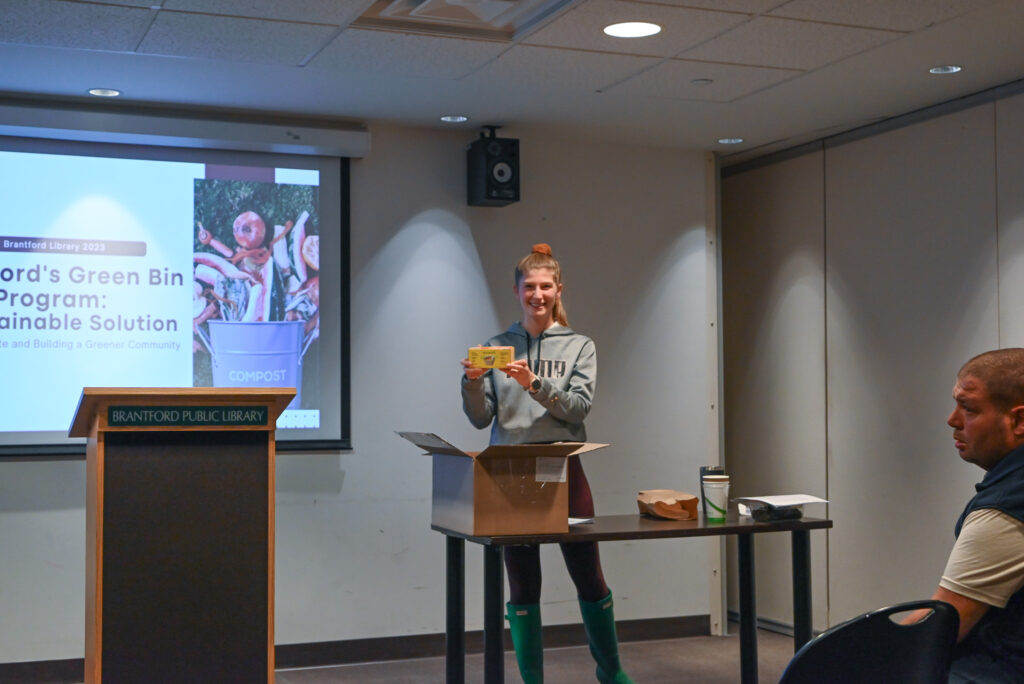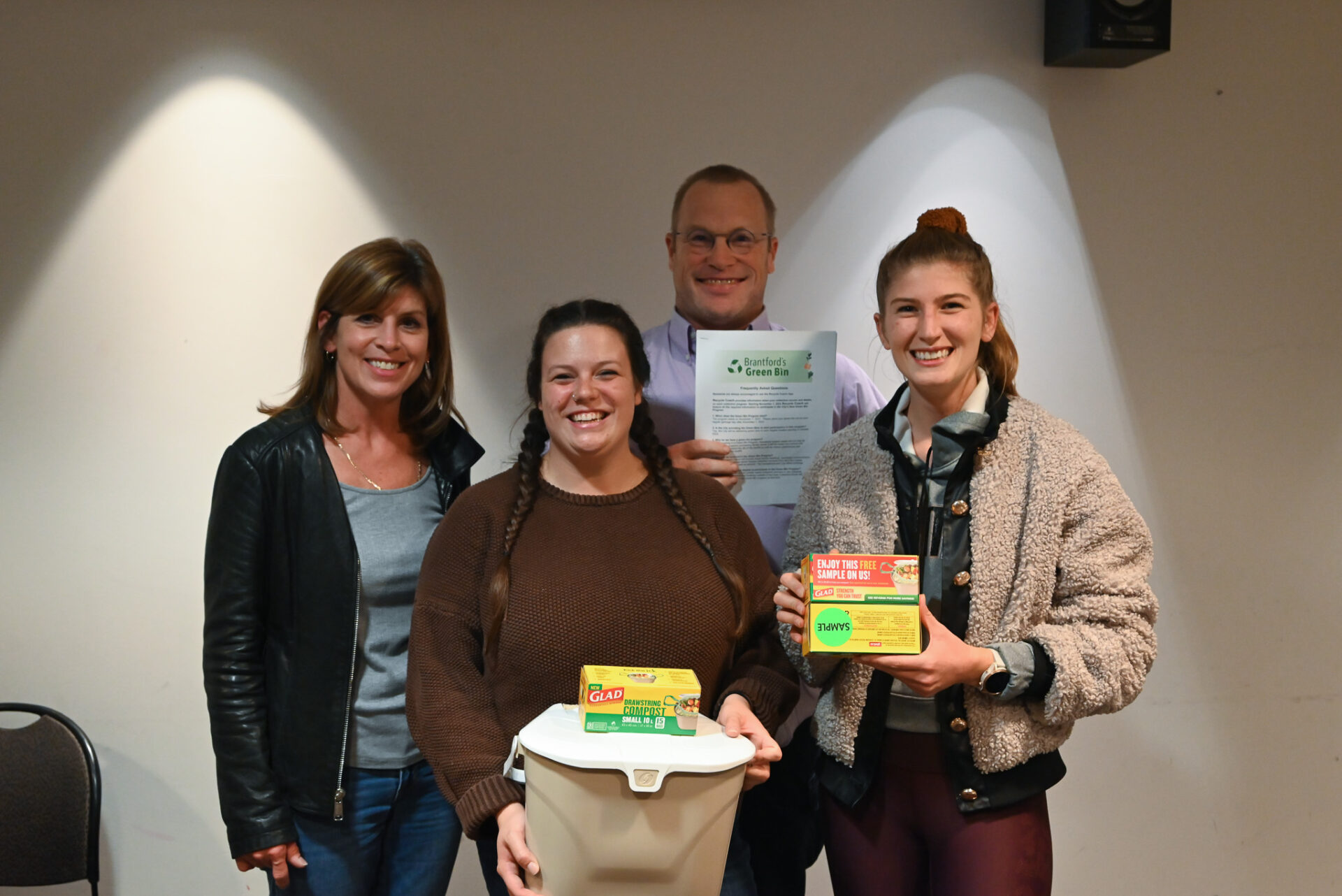Representatives from the City’s Green Team and Equal Ground Community Gardens (EGCG) spoke to residents about Brantford’s new green bin program at the Brantford Public Library on Wednesday, October 25, 2023.
The program will officially be launching on Wednesday, November 1, 2023 and residents should be receiving green bin containers, educational resources and a smaller kitchen catcher bin in the coming days, if they haven’t already.
The initial program rollout includes single family dwellings, residential condominiums, multi-residential buildings, schools, City recreational buildings and office buildings.
Taylor Edwards, the EGCG Greenhouse and Learning Centre Coordinator, said that it was important to note that for those living in residential condominiums or apartment buildings who have private waste collection, they will not be a part of the City’s green bin program.
“Though you can reach out to your landlord or condo board and say, ‘hey I would like to advocate for you to opt into this program,’ she said. “And you can encourage them to participate in either the City’s green bin program or invest in their own organic waste program.”
Allison Pepper, a City of Brantford employee, also noted that while schools are on the list for the initial rollout, residents will be receiving them first.
So why is a green bin program important?
Currently, 34 per cent of the trash produced in Brantford is being diverted from landfill and the goal is to reach 70 per cent by 2050.
Edwards read a quote from the W2RO 2021 landfill report, that states that in nine years, Ontario’s landfills will be exhausted.
“Based on the current landfill capacity depletion rate, Ontario’s available landfill capacity is expected to be exhausted by the year 2032. That means we won’t have a place to put our trash, that’s how much trash we’re producing,” she said.

She noted that municipalities like Toronto, are currently put its trash on trucks and shipping it to Michigan because it doesn’t have the landfill space.
“If the United States were to prohibit Ontario waste from crossing the border, Ontario’s landfill capacity would be exhausted by 2028. That’s how much trash we’re producing and it’s a little bit embarrassing because we should be owning that trash,” she said. “We should be taking care of it and should be processing it ourselves because that is our trash and it belongs to us. It doesn’t matter if you put it out on road and the collector comes and takes it, we’re still a part of that problem. This is why the green bin program is incredibly important to be able to continue to have a local place to dispose of our trash.
As of November 1, residents will be able to put out their green bins once a week, but it’s important to note that there is a weight limit of 55 pounds, though if a household finds they are exceeding that limit, they will be able to put out another green bin as well.
But where do the contents of the green bins go after they’ve been picked up?
The green bins will be picked up and sent to a landfill transfer station before heading to Walker Industries in Arthur where it will go through GORE Technology (piling the contents in a field to be covered with a row cover to break down) to be turned into compost and distributed to sellers.
So what CAN you put in your green bin anyway?
Acceptable food waste:
· Baked goods (cakes, pies, muffins, cookies snack foods, etc.)
· Breads, buns, pitas, etc.
· Coffee grounds and filters, tea bags and leaves
· Corn cobs and husks
· Dairy products *should be frozen until day of pickup*
· Eggs and eggshells
· Food liquids including oils and grease (500 ml or less) Frozen foods (all packaging removed)
· Fruits and seeds
· Meat, poultry and fish (including bones) *should be frozen until day of pickup*
· Nuts Pasta, flour and grains
· Pet food (wet and dry) and bird seed
· Pumpkins (in pieces)
· Salads and dressings
· Sauces and gravies
· Solid fats/grease (lard, butter and bacon fat)
· Syrups, jams, jellies and food spreads such as peanut butter
· Vegetables and peelings
Acceptable paper items:
· Paper bags (popcorn, sugar, potato and flour)
· Paper muffin cups
· Paper plates and cups
· Paper takeout containers
· Paper towels, napkins and tissues
· Parchment paper
· Pizza boxes (broken down)
Other acceptable compostable items:
· Cut flowers (all containers and decorations removed)
· House plants (with soil, containers and decorations removed), stem less than 1° (2.5cm) in diameter.
· Shredded paper
Here some items that CANNOT be put in the green bin:
· Diapers
· Hygiene products
· Noxious/toxic plants and weeds as defined by the Weed Control Act
· Grass Clippings
· Pet waste
· Plastic bags
· Coffee cups (Tim Hortons, Starbucks, etc. *Even if they look like they are paper)
Edwards noted that green bins can cause odors and be messy but suggested that for those looking to keep it in a clean state, people can use paper bags or newspaper to line the bottom to soak up liquids and recommends rinsing it out weekly to avoid pests and maggots.
She also noted that if people are interested in using liners for their green bins, they should look for ones that have a BPI approved label.
For those looking for further resources, they can visit the City of Brantford website or download the app Recycle Coach. The app has a search function that tells you what products belong in the trash, green bin or recycling bin.
Kimberly De Jong’s reporting is funded by the Canadian government through its Local Journalism Initiative.The funding allows her to report rural and agricultural stories from Blandford-Blenheim and Brant County. Reach her at kimberly.dejong@brantbeacon.ca.
